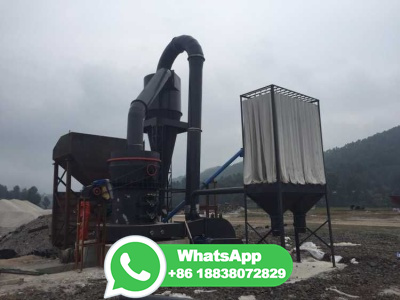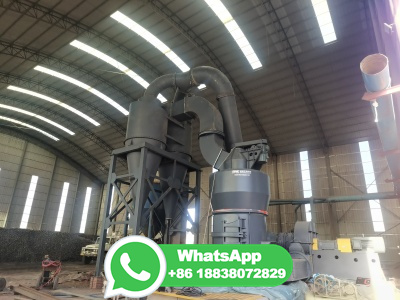
In 2015, the US Geological Survey estimated that over 95% of bauxite was converted to alumina, with the remainder going toward a variety of products such as abrasives, chemicals, proppants, and more. The primary approach to transforming bauxite ore to alumina is known as the Bayer Process.
WhatsApp: +86 18203695377
ISBN Foreword This book is designed as an introductory text to the extraction of alumina, the feedstock for aluminium production, from bauxite ore. The audience is high school students and teachers, university undergraduates and people starting work in the alumina/aluminium industry.
WhatsApp: +86 18203695377
PROCESS DESCRIPTION: BAUXITE MINING Bauxite is the principal ore of alumina (Al 2 O 3 ), which is used to produce aluminum (Al). It is composed of hydrated aluminum oxides, hydrated aluminosilicates, iron oxides, hydrated iron oxides, titanium oxide, and silica.
WhatsApp: +86 18203695377
The global bauxite market is projected to reach US billion by 2030, at a CAGR of %. Production of bauxite is concentrated in a few countries, with Australia, China, and Guinea being the ...
WhatsApp: +86 18203695377
Abstract Bauxite mining and alumina refining are the upstream operations of primary aluminum production. This review article describes the industrial processes of bauxite mining and alumina refining and outlines the physical, chemical, biological, ergonomic, and psychosocial health risks. PROCESS DESCRIPTION: BAUXITE MINING
WhatsApp: +86 18203695377
In most commercial operations, alumina is extracted (refined) from bauxite by a wet chemical caustic leach process known as the Bayer process. The alumina is then smelted using the energyintensive HallHeroult process to produce aluminium metal by electrolytic reduction in a molten bath of natural or synthetic cryolite (NaAlF 6). Australia is ...
WhatsApp: +86 18203695377
Bauxite residue (BR) is a solid waste generated from the Bayer process during alumina production after the significant removal of water from red mud [1, 2]. Iron contained in the BR is high and ...
WhatsApp: +86 18203695377
Red mud near Stade Bauxite, an aluminium ore (Hérault department, France).The reddish colour is due to iron oxides that make up the main part of the red mud.. Red mud, now more frequently termed bauxite residue, is an industrial waste generated during the processing of bauxite into alumina using the Bayer is composed of various oxide compounds, including the iron oxides which give ...
WhatsApp: +86 18203695377
Bauxite is the primary ore for aluminium, and it undergoes an intermediate refining stage, known as the Bayer process, to produce alumina, which is then subjected to electrolysis to produce aluminium. This refining process generates bauxite residue as a byproduct. To produce 1 kg of aluminium, it requires 2 kg of alumina, which consumes 6 kg ...
WhatsApp: +86 18203695377
disclosing company proprietary data. In 2022, the reported quantity of bauxite consumed was estimated to be million tons, 4% more than that reported in 2021, with an estimated value of about 87 million. About 76% of the bauxite was refined by the Bayer process for alumina or aluminum hydroxide, and the remainder went to products
WhatsApp: +86 18203695377
Red mud, also referred to as bauxite residue, is the largest process waste produced during alumina production from bauxite ore by the Bayer method. Approximately 12 tons of red mud are produced ...
WhatsApp: +86 18203695377
Australia is the world's secondlargest producer of alumina and its largest exporter. Alumina is mostly used to make aluminium but it also has many other uses such as glass, porcelain and paint manufacturing. There are two key processes in an alumina refinery. Firstly, the Bayer process uses steam to extract alumina crystals from the bauxite ...
WhatsApp: +86 18203695377
The Bayer Process is the dominant industrial method to produce alumina from bauxite ore. Due to the generation of large amounts of Bauxite Residue (red mud), an alternative method, called the Pedersen Process, is of our interest. This process makes use of a combination of pyrometallurgical and hydrometallurgical techniques in order to prevent the Bauxite Residue generation. In the conventional ...
WhatsApp: +86 18203695377
Two to three tonnes of bauxite are required to produce one tonne of alumina. 90% of the global alumina supply of around 90 million tonnes is used in aluminium production. Alumina refineries tend to be located close to bauxite mines and/or ports for efficient transport of raw materials and of the final product. Downloads (Adobe Reader required)
WhatsApp: +86 18203695377
BAUXITE AND ALUMINA1 (Data in thousand metric dry tons unless otherwise noted) Domestic Production and Use: In 2019, the quantity of bauxite consumed was estimated to be million tons, 30% more than that reported in 2018, with an estimated value of about 162 million.
WhatsApp: +86 18203695377
About 79% of the bauxite was refined by the Bayer process for alumina or aluminum hydroxide, and the remainder went to products such as abrasives, cement, chemicals, proppants, and refractories, and as a slag adjuster in steel mills.
WhatsApp: +86 18203695377
The HallHéroult process is the major industrial process for smelting involves dissolving aluminium oxide (alumina) (obtained most often from bauxite, aluminium's chief ore, through the Bayer process) in molten cryolite, and electrolyzing the molten salt bath, typically in a purposebuilt cell. The HallHéroult process applied at industrial scale happens at 940980 °C and ...
WhatsApp: +86 18203695377
Aluminum production first begins with smelters extracting aluminum from bauxite (sedimentary rock) during a twostep aluminum smelting process. This twostep process involves the Bayer process to extract alumina from bauxite, followed by the HallHéroult process to produce pure aluminum. Each step halves the material quantity, and refining two ...
WhatsApp: +86 18203695377
The ore is then concentrated by a chemical process. Bauxite is the name given to aluminium ore. To generate aluminium oxide, bauxite is purified, a white powder from which aluminium can be extracted. Aluminium oxide has a very high melting point of more than 2000° C which makes melting very expensive.
WhatsApp: +86 18203695377
The excessive production of bauxite residue (red mud) in the Bayer process is one of the major challenges amongst alumina producers. The Pedersen process is known as a combination of smelting reduction of bauxite and leaching treatment of the produced slag for alumina production, and the process also produces an inert bauxite residue (grey mud), which is more suitable for further processing ...
WhatsApp: +86 18203695377
He continued work on a second successful process that produced an aluminumcopper alloy. Conveniently, in 1888, an Austrian chemist, Karl Joseph Bayer, discovered an improved method for making pure alumina from lowsilica bauxite ores. Hall and a group of businessmen established the Pittsburgh Reduction Company in 1888 in Pittsburgh. The first ...
WhatsApp: +86 18203695377
C. The importance of the aluminium sector to Brazil 11 II. ENVIRONMENTAL EFFECTS OF PRODUCING BAUXITE, ALUMINA AND ALUMINIUM 13 A. Introduction 13 B. Bauxite mining 14 1. MRN 14 Revegetation 14 Bauxite Tailings Disposal 14 Rehabilitation of Lake Batata 15 Control of solid particles emissions 17 MRN's environmental policy 17 2.
WhatsApp: +86 18203695377
Aluminum ore, also known as bauxite, is a naturally occurring mineral rock that contains aluminum in the form of aluminum oxide (Al2O3) mixed with various impurities. Bauxite is the primary source of aluminum, which is one of the most abundant elements in the Earth's crust, comprising about 8% by weight. ... Bayer process for bauxite: Bauxite ...
WhatsApp: +86 18203695377
2. Bayer process alumina production. Bauxite ore is the main raw material used in alumina production. The alumina production in major regions of the world in 2017 is shown in Figure 1. It can be seen that the growth in aluminum production continues to be driven by countries in Asia and the Gulf area, 2017 global aluminum production is nearly ...
WhatsApp: +86 18203695377
Aluminium smelting is the process of extracting aluminium from its oxide, alumina, generally by the HallHéroult is extracted from the ore bauxite by means of the Bayer process at an alumina refinery.. This is an electrolytic process, so an aluminium smelter uses huge amounts of electric power; smelters tend to be located close to large power stations, often hydroelectric ...
WhatsApp: +86 18203695377
obtain aluminium oxide (which is carried out at AAL), and the HallHeroult process of smelting the aluminium oxide to release pure aluminium (the smelting process is not carried out at AAL). The first step is the separation of aluminium oxide from iron oxide and other impurities in bauxite. This is accomplished using a technique developed by ...
WhatsApp: +86 18203695377
Alumina production: Bayer process: calcination . Alumina is produced from bauxite in the wellestablished Bayer process, followed by a calcination process. This Bayer process was invented in 1888 by Carl Josef Bayer and contributed with the development of aluminium to the ongoing industrial revolution. The Bayer process produces pure ...
WhatsApp: +86 18203695377
This process involves the separation of alumina from unwanted components such as iron, titanium, silica, calcium, vanadium, manganese, etc., in bauxite. In this process, bauxite is heated along with the caustic soda at high pressure (~30 atm), resulting in the formation of sodium aluminate (reactions (1)(4)) (Gil, 2005; Ma et al., 2009).
WhatsApp: +86 18203695377
Mined bauxite ore is refined into alumina through what is known as the Bayer process. The process, discovered in 1887, extracts alumina from bauxite through crushing, dissolving it in caustic soda, filtration and an electrolytic process. Alumina is a white powder, appearing similar to table salt, which can then be smelted into aluminium metal.
WhatsApp: +86 18203695377
Stage 2: Alumina production. In the 1890s, Austrian chemist Carl Josef Bayer invented a revolutionary process for extracting alumina from bauxite. Today—over 100 years later—some 90% of ...
WhatsApp: +86 18203695377
The Bayer process is the principal industrial means of refining bauxite to produce alumina (aluminium oxide) and was developed by Carl Josef Bayer. Bauxite, the most important ore of aluminium, contains only 3060% aluminium oxide (Al 2 O 3 ), the rest being a mixture of silica, various iron oxides, and titanium dioxide. [1]
WhatsApp: +86 18203695377
After bauxite is out of the ground, it is sent to refineries across the globe to make alumina, marking the second stage of the production process. Stage 2: Alumina Production. In the 1890s, Austrian chemist Carl Josef Bayer invented a revolutionary process for extracting alumina from bauxite.
WhatsApp: +86 18203695377
The process of extracting bauxite has been used for centuries, but the arrival of modern technology has made bauxite mining an important part of the global economy. ... The company produces highquality primary bauxite and alumina concentrates, as well as aluminum products, using its primary and concentrate resources. In addition to these ...
WhatsApp: +86 18203695377
As with the HallHéroult process for metal production, alumina production has grown steadily with minimal change to the Bayer process, driven by a steadily increasing demand for the metal, and in lesser quantities, for specialty oxides. For every tonne of primary metal, tonnes of alumina are required.
WhatsApp: +86 18203695377